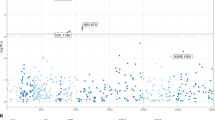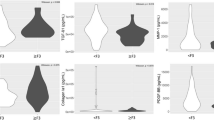Abstract
Interferon stimulates the expression of a number of genes encoding enzymes with antiviral activities, including myxovirus resistance-1 (MxA), 2-5-oligoadenylate synthetase 1 (OAS-1) and double-stranded RNA-dependent protein kinase (PKR). We examined whether polymorphisms in these genes influenced the outcome of hepatitis C virus (HCV) infection. We observed a lower frequency of the GG genotype at position −88 in the MxA gene promoter in self-limiting HCV infection (OR=0.56; 95% CI: 0.35–0.8; P=0.010) and in nonresponders to therapy (OR=0.49; 95% CI: 0.25–0.95; P=0.020). This genotype predominantly influenced the outcome of treatment in patients with viral genotype 1 (OR=0.22 95% CI: 0.07–0.67; P=0.002). A polymorphism in the 3′-untranslated region of the OAS-1 gene was associated with outcome of infection (GG genotype less frequent in self-limiting infection: OR=0.43; 95% CI: 0.21–0.86; P=0.010). A polymorphism at position −168 in the promoter region of the PKR gene was associated with self-limiting infection (CT genotype: OR=2.75; 95% CI: 1.45–5.24; P=0.002). Further associations were found with a CGG trinucleotide repeat in the 5′UTR region of the PKR gene. Polymorphisms in the interferon-induced genes, MxA, OAS-1 and PKR appear thus associated with HCV outcome.
This is a preview of subscription content, access via your institution
Access options
Subscribe to this journal
Receive 6 digital issues and online access to articles
$119.00 per year
only $19.83 per issue
Buy this article
- Purchase on Springer Link
- Instant access to full article PDF
Prices may be subject to local taxes which are calculated during checkout
Similar content being viewed by others
References
Staeheli P . Interferon-induced proteins and the antiviral state. Adv Virus Res 1990; 38: 147–200.
Zhao H, De BP, Das T, Banerjee AK . Inhibition of human parainfluenza virus-3 replication by interferon and human MxA. Virology 1996; 220: 330–338.
Landis H, Simon-Jodicke A, Kloti A et al. Human MxA protein confers resistance to Semliki Forest virus and inhibits the amplification of a Semliki Forest virus-based replicon in the absence of viral structural proteins. J Virol 1998; 72: 1516–1522.
Hefti HP, Frese M, Landis H et al. Human MxA protein protects mice lacking a functional alpha/beta interferon system against La crosse virus and other lethal viral infections. J Virol 1999; 73: 6984–6991.
Fernandez M, Quiroga JA, Martin J et al. In vivo and in vitro induction of MxA protein in peripheral blood mononuclear cells from patients chronically infected with hepatitis C virus. J Infect Dis 1999; 180: 262–267.
Antonelli G, Simeoni E, Turriziani O et al. Correlation of interferon-induced expression of MxA mRNA in peripheral blood mononuclear cells with the response of patients with chronic active hepatitis C to IFN-alpha therapy. J Interferon Cytokine Res 1999; 19: 243–251.
Castelli J, Wood KA, Youle RJ . The 2-5A system in viral infection and apoptosis. Biomed Pharmacother 1998; 52: 386–390.
Pestka S, Langer JA, Zoon KC, Samuel CE . Interferons and their actions. Annu Rev Biochem 1987; 56: 727–777.
Huang JT, Schneider RJ . Adenovirus inhibition of cellular protein synthesis involves inactivation of cap-binding protein. Cell 1991; 65: 271–280.
O’Malley RP, Mariano TM, Siekierka J, Mathews MB . A mechanism for the control of protein synthesis by adenovirus VA RNAI. Cell 1986; 44: 391–400.
Clemens MJ . PKR—a protein kinase regulated by double-stranded RNA. Int J Biochem Cell Biol 1997; 29: 945–949.
Gale Jr MJ, Korth MJ, Tang NM et al. Evidence that hepatitis C virus resistance to interferon is mediated through repression of the PKR protein kinase by the nonstructural 5A protein. Virology 1997; 230: 217–227.
Davis GL, Balart LA, Schiff ER et al. Treatment of chronic hepatitis C with recombinant interferon alfa. A multicenter randomized, controlled trial. Hepatitis Interventional Therapy Group. N Engl J Med 1989; 321: 1501–1506.
Di Bisceglie AM, Martin P, Kassianides C et al. Recombinant interferon alfa therapy for chronic hepatitis C. A randomized, double-blind, placebo-controlled trial. N Engl J Med 1989; 321: 1506–1510.
Poynard T, Marcellin P, Lee SS et al. Randomised trial of interferon alpha2b plus ribavirin for 48 weeks or for 24 weeks versus interferon alpha2b plus placebo for 48 weeks for treatment of chronic infection with hepatitis C. virus. International Hepatitis Interventional Therapy Group (IHIT). Lancet 1998; 352: 1426–1432.
McHutchison JG, Gordon SC, Schiff ER et al. Interferon alfa-2b alone or in combination with ribavirin as initial treatment for chronic hepatitis C. Hepatitis Interventional Therapy Group [see comments]. N Engl J Med 1998; 339: 1485–1492.
Zeuzem S, Herrmann E, Lee JH et al. Viral kinetics in patients with chronic hepatitis C treated with standard or peginter-feron alpha2a. Gastroenterology 2001; 120: 1438–1447.
Manns MP, McHutchison JG, Gordon SC et al. Peginterferon alfa-2b plus ribavirin compared with interferon alfa-2b plus ribavirin for initial treatment of chronic hepatitis C: a randomised trial. Lancet 2001; 358: 958–965.
Der SD, Zhou A, Williams BR, Silverman RH . Identification of genes differentially regulated by interferon alpha, beta, or gamma using oligonucleotide arrays. Proc Natl Acad Sci USA 1998; 95: 15623–15628.
Hijikata M, Ohta Y, Mishiro S . Identification of a single nucleotide polymorphism in the MxA gene promoter (G/T at nt −88) correlated with the response of hepatitis C patients to interferon1. Intervirology 2000; 43: 124–127.
Kuhen KL, Samuel CE . Isolation of the interferon-inducible RNA-dependent protein kinase Pkr promoter and identification of a novel DNA element within the 5′-flanking region of human and mouse Pkr genes. Virology 1997; 227: 119–130.
Xu Z, Williams BR . Genomic features of human PKR: alternative splicing and a polymorphic CGG repeat in the 5′-untranslated region. J Interferon Cytokine Res 1998; 18: 609–616.
Hijikata M, Mishiro S, Miyamoto C et al. Genetic polymorphism of the MxA gene promoter and interferon responsiveness of hepatitis C patients: revisited by analyzing two SNP sites (−123 and −88) in vivo and in vitro. Intervirology 2001; 44: 379–382.
Pawlotsky JM, Hovanessian A, Roudot-Thoraval F et al. Activity of the interferon-induced 2′,5′-oligoadenylate synthetase in patients with chronic hepatitis C. J Interferon Cytokine Res 1995; 15: 857–862.
Solinas A, Cossu P, Poddighe P et al. Changes of serum 2′,5′-oligoadenylate synthetase activity during interferon treatment of chronic hepatitis C. Liver 1993; 13: 253–258.
Okuno T, Shindo M, Arai K et al. 2′,5′-oligoadenylate synthetase activity in peripheral blood mononuclear cells and serum during interferon treatment of chronic non-A, non-B hepatitis. Gastroenterol Jpn 1991; 26: 603–610.
Okuno T, Shindo M, Arai K et al. Determination of 2′, 5′ oligoa-denylate synthetase acitvity in acute non-A, non-B hepatitis patients, with special reference of histological outcome. Viral Hepatitis C, D and E. Elsevier: Amsterdam, 1991, pp 133–135.
Karino Y, Hige S, Saga A et al. Relationship Between Serum 2′-5′ Oligoadenylate Synthase Activity and the Reduction of HCV-RNA During Interferon Therapy. Springer: Tokyo, 1994, pp 631–634.
Verkerk AJ, Pieretti M, Sutcliffe JS et al. Identification of a gene (FMR-1) containing a CGG repeat coincident with a breakpoint cluster region exhibiting length variation in fragile X syndrome. Cell 1991; 65: 905–914.
Aidoo M, Terlouw DJ, Kolczak MS et al. Protective effects of the sickle cell gene against malaria morbidity and mortality. Lancet 2002; 359: 1311–1312.
Thursz MR, Thomas HC, Greenwood BM, Hill AV . Heterozygote advantage at the MHC class II loci in the outcome of HBV infection. Nat Genet 1997; 17: 10–11.
Rothman KJ . No adjustments are needed for multiple comparisons. Epidemiology 1990; 1: 43–46.
Thursz MR, Yallop R, Goldin R, Trepo C, Thomas HC . Influence of MHC class II genotype on outcome of infection with hepatitis C virus. Lancet 1999; 354: 2119–2124.
Germer S, Holland MJ, Higuchi R . High-throughput SNP allele-frequency determination in pooled DNA samples by kinetic PCR. Genome Res 2000; 10: 258–266.
Acknowledgements
The HENCORE group (Hepatitis C European Network for Cooperative Research) includes: Robert Goldin and Rhiannon Yallop (London, UK), Pierre Pradat and Christian Trepo (Lyon, France), Juan Esteban (Barcelona, Spain), Stephanos Hadziyannis (Athens, Greece), Michael Manns and Hans Tillmann (Hannover, Germany), Alfredo Alberti and Liliana Chemello (Padova, Italy), Giorgio Saracco (Torino, Italy), Mario Rizzetto (Turin, Italy), Jean-Henrik Braconier (Stockholm, Sweden).
Special thanks go to the patients and their families for their cooperation and participation in this study. This work was funded by Roche Discovery, Welwyn, UK. We are grateful for financial support from the UK Department of Health; the views expressed in this publication are those of the authors and not necessarily those of the Department of Health. AJF was supported by a Wellcome Trust Research Training and AVSH by a Wellcome Trust Principal Research Fellowship. MW is an MRC Clinical Training Fellow. We are also indebted to Dr Carla Venturi-Passini and Dr Salvatori Lobello for their technical assistance.
Author information
Authors and Affiliations
Corresponding author
Rights and permissions
About this article
Cite this article
Knapp, S., Yee, L., Frodsham, A. et al. Polymorphisms in interferon-induced genes and the outcome of hepatitis C virus infection: roles of MxA, OAS-1 and PKR. Genes Immun 4, 411–419 (2003). https://doi.org/10.1038/sj.gene.6363984
Published:
Issue Date:
DOI: https://doi.org/10.1038/sj.gene.6363984
Keywords
This article is cited by
-
Modelling the impact of protein-kinase R allelic variant on HIV biomarkers trajectories by means of latent class mixed models
Scientific Reports (2022)
-
Human gene polymorphisms and their possible impact on the clinical outcome of SARS-CoV-2 infection
Archives of Virology (2021)
-
Mx genes: host determinants controlling influenza virus infection and trans-species transmission
Human Genetics (2020)
-
Molecular Cloning and Identification of the 2′–5′ Oligoadenylate Synthetase 2 Gene in Chinese Domestic Pigs Through Bioinformatics Analysis, and Determination of Its Antiviral Activity Against Porcine Reproductive and Respiratory Syndrome Virus Infection
Indian Journal of Microbiology (2018)
-
A Modified Coupled Spectrophotometric Method to Detect 2-5 Oligoadenylate Synthetase Activity in Prostate Cell Lines
Biological Procedures Online (2016)



